FIAT SCUDO 2015 Owner handbook (in English)
Manufacturer: FIAT, Model Year: 2015, Model line: SCUDO, Model: FIAT SCUDO 2015Pages: 227, PDF Size: 4.46 MB
Page 161 of 227
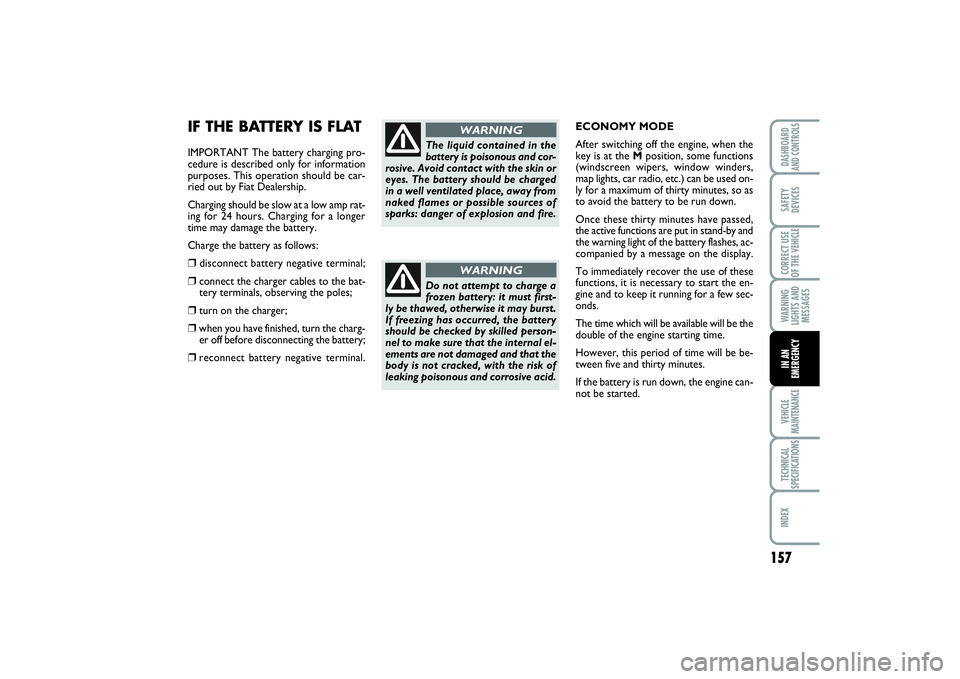
157
WARNING
LIGHTS AND
MESSAGESVEHICLE
MAINTENANCETECHNICAL
SPECIFICATIONSINDEXDASHBOARD
AND CONTROLSSAFETY
DEVICESCORRECT USE
OF THE VEHICLEIN AN
EMERGENCY
IF THE BATTERY IS FLATIMPORTANT The battery charging pro-
cedure is described only for information
purposes. This operation should be car-
ried out by Fiat Dealership.
Charging should be slow at a low amp rat-
ing for 24 hours. Charging for a longer
time may damage the battery.
Charge the battery as follows:❒
disconnect battery negative terminal;
❒
connect the charger cables to the bat-
tery terminals, observing the poles;
❒
turn on the charger;
❒
when you have finished, turn the charg-
er off before disconnecting the battery;
❒
reconnect battery negative terminal.
The liquid contained in the
battery is poisonous and cor-
rosive. Avoid contact with the skin or
eyes. The battery should be charged
in a well ventilated place, away from
naked flames or possible sources of
sparks: danger of explosion and fire.
WARNING
Do not attempt to charge a
frozen battery: it must first-
ly be thawed, otherwise it may burst.
If freezing has occurred, the battery
should be checked by skilled person-
nel to make sure that the internal el-
ements are not damaged and that the
body is not cracked, with the risk of
leaking poisonous and corrosive acid.
WARNING
ECONOMY MODE
After switching off the engine, when the
key is at the Mposition, some functions
(windscreen wipers, window winders,
map lights, car radio, etc.) can be used on-
ly for a maximum of thirty minutes, so as
to avoid the battery to be run down.
Once these thirty minutes have passed,
the active functions are put in stand-by and
the warning light of the battery flashes, ac-
companied by a message on the display.
To immediately recover the use of these
functions, it is necessary to start the en-
gine and to keep it running for a few sec-
onds.
The time which will be available will be the
double of the engine starting time.
However, this period of time will be be-
tween five and thirty minutes.
If the battery is run down, the engine can-
not be started.
139-158 SCUDO LUM GB 07/03/14 08.47 Pagina 157
Page 162 of 227
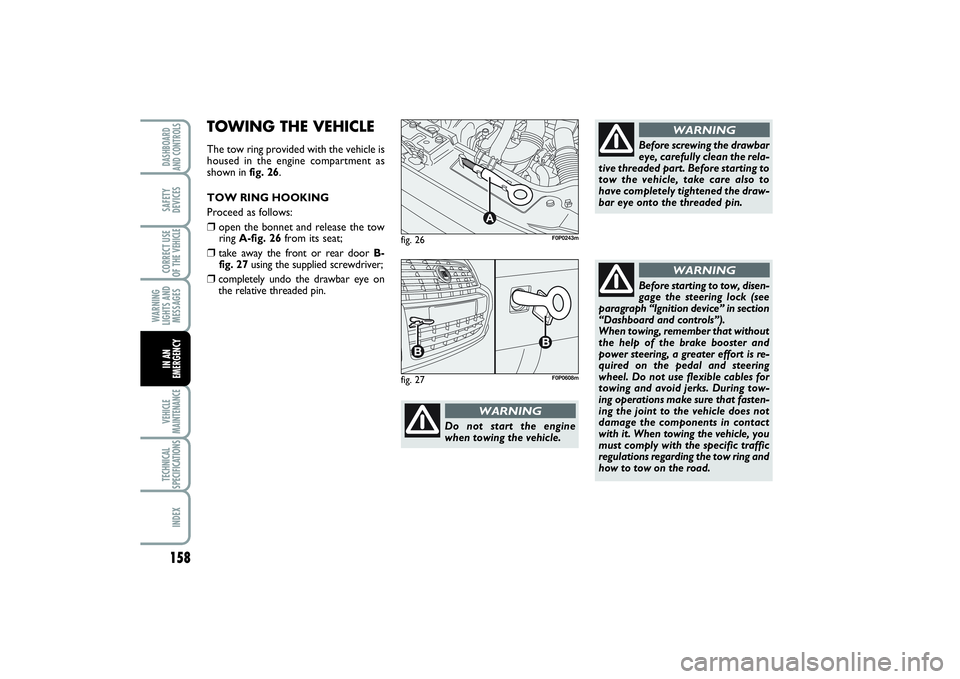
158WARNING
LIGHTS AND
MESSAGESVEHICLE
MAINTENANCETECHNICAL
SPECIFICATIONSINDEXDASHBOARD
AND CONTROLSSAFETY
DEVICESCORRECT USE
OF THE VEHICLEIN AN
EMERGENCY
fig. 26
A
F0P0243m
Do not start the engine
when towing the vehicle.
WARNING
Before screwing the drawbar
eye, carefully clean the rela-
tive threaded part. Before starting to
tow the vehicle, take care also to
have completely tightened the draw-
bar eye onto the threaded pin.
WARNING
Before starting to tow, disen-
gage the steering lock (see
paragraph “Ignition device” in section
“Dashboard and controls”).
When towing, remember that without
the help of the brake booster and
power steering, a greater effort is re-
quired on the pedal and steering
wheel. Do not use flexible cables for
towing and avoid jerks. During tow-
ing operations make sure that fasten-
ing the joint to the vehicle does not
damage the components in contact
with it. When towing the vehicle, you
must comply with the specific traffic
regulations regarding the tow ring and
how to tow on the road.
WARNING
fig. 27
F0P0608m
TOWING THE VEHICLEThe tow ring provided with the vehicle is
housed in the engine compartment as
shown in fig. 26.
TOW RING HOOKING
Proceed as follows:❒
open the bonnet and release the tow
ring A-fig. 26from its seat;
❒
take away the front or rear door B-
fig. 27using the supplied screwdriver;
❒completely undo the drawbar eye on
the relative threaded pin.
139-158 SCUDO LUM GB 07/03/14 08.47 Pagina 158
Page 163 of 227
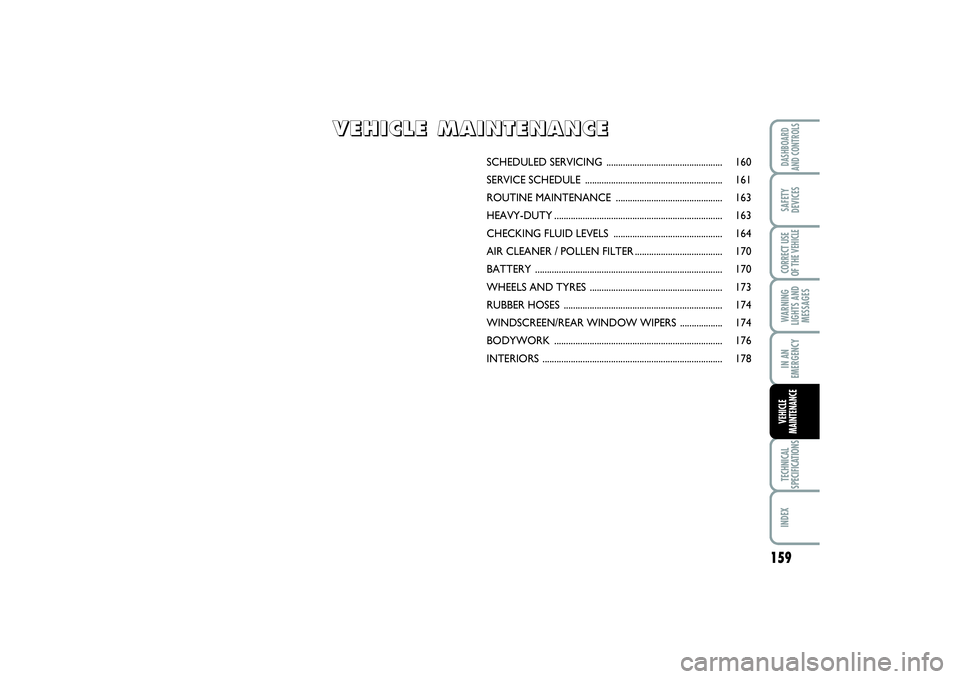
159
WARNING
LIGHTS AND
MESSAGESTECHNICAL
SPECIFICATIONSINDEX DASHBOARD
AND CONTROLSSAFETY
DEVICESCORRECT USE
OF THE VEHICLEIN AN
EMERGENCYVEHICLE
MAINTENANCE
SCHEDULED SERVICING ................................................. 160
SERVICE SCHEDULE .......................................................... 161
ROUTINE MAINTENANCE ............................................. 163
HEAVY-DUTY ....................................................................... 163
CHECKING FLUID LEVELS .............................................. 164
AIR CLEANER / POLLEN FILTER..................................... 170
BATTERY ............................................................................... 170
WHEELS AND TYRES ........................................................ 173
RUBBER HOSES ................................................................... 174
WINDSCREEN/REAR WINDOW WIPERS .................. 174
BODYWORK ....................................................................... 176
INTERIORS ............................................................................ 178
V V
E E
H H
I I
C C
L L
E E
M M
A A
I I
N N
T T
E E
N N
A A
N N
C C
E E
159-178 SCUDO LUM GB 12/12/13 10.02 Pagina 159
Page 164 of 227
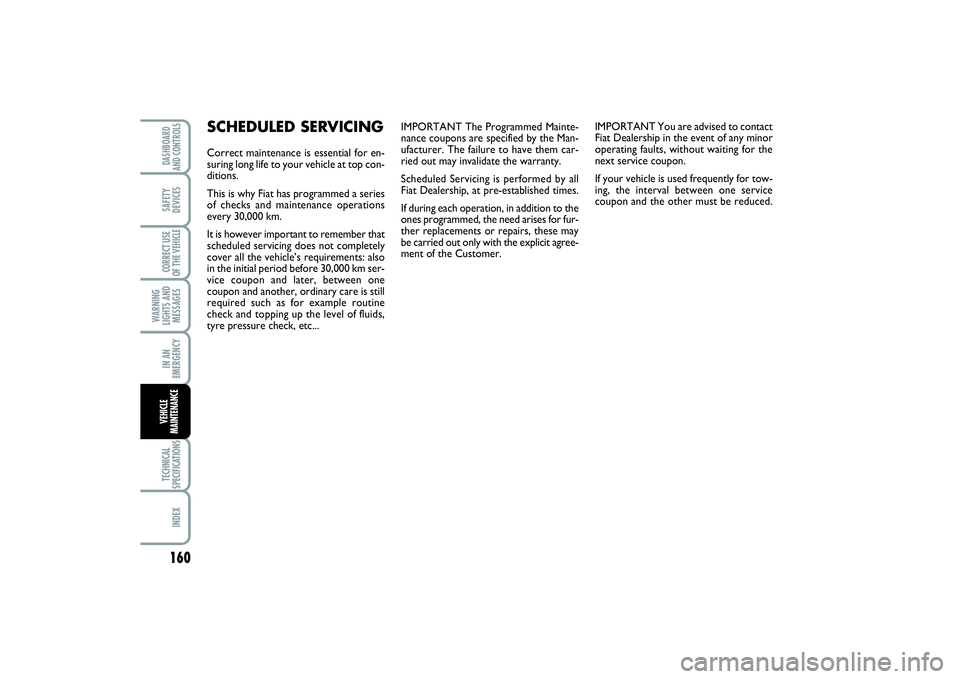
IMPORTANT The Programmed Mainte-
nance coupons are specified by the Man-
ufacturer. The failure to have them car-
ried out may invalidate the warranty.
Scheduled Servicing is performed by all
Fiat Dealership, at pre-established times.
If during each operation, in addition to the
ones programmed, the need arises for fur-
ther replacements or repairs, these may
be carried out only with the explicit agree-
ment of the Customer.IMPORTANT You are advised to contact
Fiat Dealership in the event of any minor
operating faults, without waiting for the
next service coupon.
If your vehicle is used frequently for tow-
ing, the interval between one service
coupon and the other must be reduced.
SCHEDULED SERVICINGCorrect maintenance is essential for en-
suring long life to your vehicle at top con-
ditions.
This is why Fiat has programmed a series
of checks and maintenance operations
every 30,000 km.
It is however important to remember that
scheduled servicing does not completely
cover all the vehicle’s requirements: also
in the initial period before 30,000 km ser-
vice coupon and later, between one
coupon and another, ordinary care is still
required such as for example routine
check and topping up the level of fluids,
tyre pressure check, etc...
160WARNING
LIGHTS AND
MESSAGESTECHNICAL
SPECIFICATIONSINDEXDASHBOARD
AND CONTROLSSAFETY
DEVICESCORRECT USE
OF THE VEHICLEIN AN
EMERGENCYVEHICLE
MAINTENANCE
159-178 SCUDO LUM GB 12/12/13 10.02 Pagina 160
Page 165 of 227
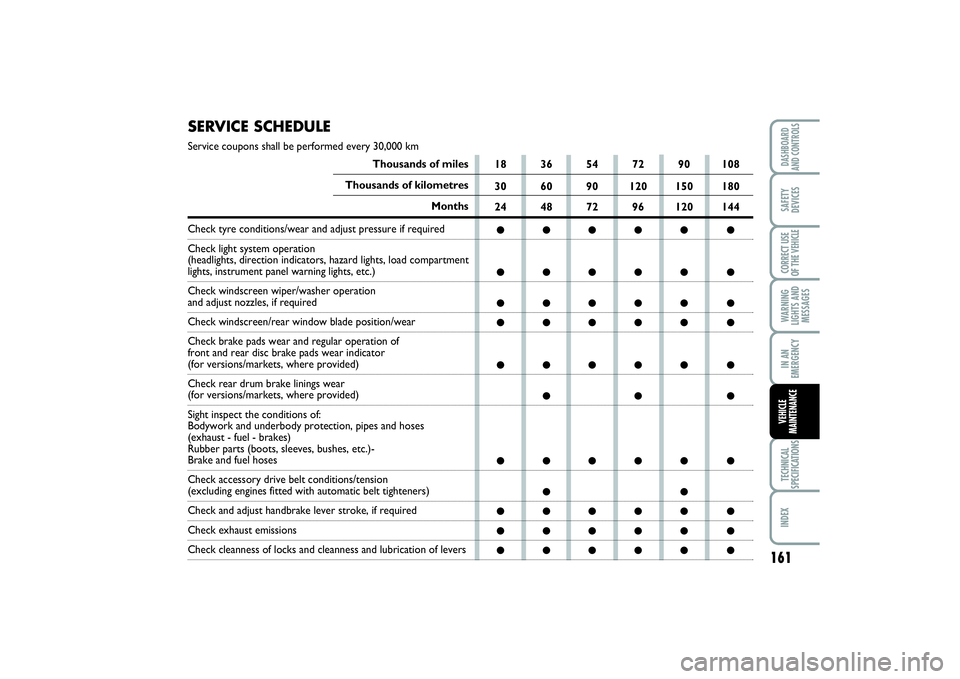
161
WARNING
LIGHTS AND
MESSAGESTECHNICAL
SPECIFICATIONSINDEX DASHBOARD
AND CONTROLSSAFETY
DEVICESCORRECT USE
OF THE VEHICLEIN AN
EMERGENCYVEHICLE
MAINTENANCE
18 36 54 72 90 108
30 60 90 120 150 180
24 48 72 96 120 144●●●●● ●
●●●●● ●
●●●●● ●
●●●●● ●
●●●●● ●
●● ●
●●●●● ●
●●
●●●●● ●
●●●●● ●
●●●●● ●
SERVICE SCHEDULEService coupons shall be performed every 30,000 km
Thousands of miles
Thousands of kilometres
Months
Check tyre conditions/wear and adjust pressure if required
Check light system operation
(headlights, direction indicators, hazard lights, load compartment lights, instrument panel warning lights, etc.)
Check windscreen wiper/washer operation and adjust nozzles, if requiredCheck windscreen/rear window blade position/wear
Check brake pads wear and regular operation of
front and rear disc brake pads wear indicator (for versions/markets, where provided)
Check rear drum brake linings wear (for versions/markets, where provided)
Sight inspect the conditions of:
Bodywork and underbody protection, pipes and hoses
(exhaust - fuel - brakes)
Rubber parts (boots, sleeves, bushes, etc.)-Brake and fuel hoses
Check accessory drive belt conditions/tension (excluding engines fitted with automatic belt tighteners)Check and adjust handbrake lever stroke, if requiredCheck exhaust emissionsCheck cleanness of locks and cleanness and lubrication of levers
159-178 SCUDO LUM GB 12/12/13 10.02 Pagina 161
Page 166 of 227
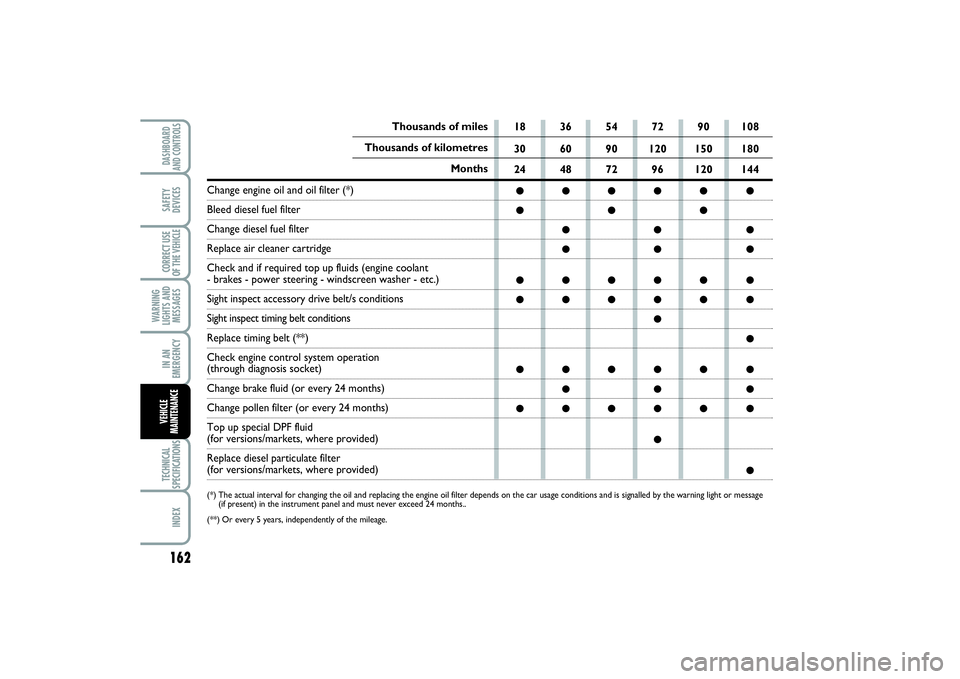
162WARNING
LIGHTS AND
MESSAGESTECHNICAL
SPECIFICATIONSINDEXDASHBOARD
AND CONTROLSSAFETY
DEVICESCORRECT USE
OF THE VEHICLEIN AN
EMERGENCYVEHICLE
MAINTENANCE
18 36 54 72 90 108
30 60 90 120 150 180
24 48 72 96 120 144●●●●● ●
●●●
●● ●
●● ●
●●●●● ●
●●●●● ●
●
●
●●●●● ●
●● ●
●●●●● ●
●
●
Thousands of miles
Thousands of kilometres
Months
Change engine oil and oil filter (*)Bleed diesel fuel filterChange diesel fuel filterReplace air cleaner cartridge
Check and if required top up fluids (engine coolant- brakes - power steering - windscreen washer - etc.)Sight inspect accessory drive belt/s conditionsSight inspect timing belt conditionsReplace timing belt (**)
Check engine control system operation(through diagnosis socket)Change brake fluid (or every 24 months)Change pollen filter (or every 24 months)
Top up special DPF fluid (for versions/markets, where provided)
Replace diesel particulate filter (for versions/markets, where provided) (*) The actual interval for changing the oil and replacing the engine oil filter depends on the car usage conditions and is signalled by the warning light or message
(if present) in the instrument panel and must never exceed 24 months..
(**) Or every 5 years, independently of the mileage.
159-178 SCUDO LUM GB 12/12/13 10.02 Pagina 162
Page 167 of 227
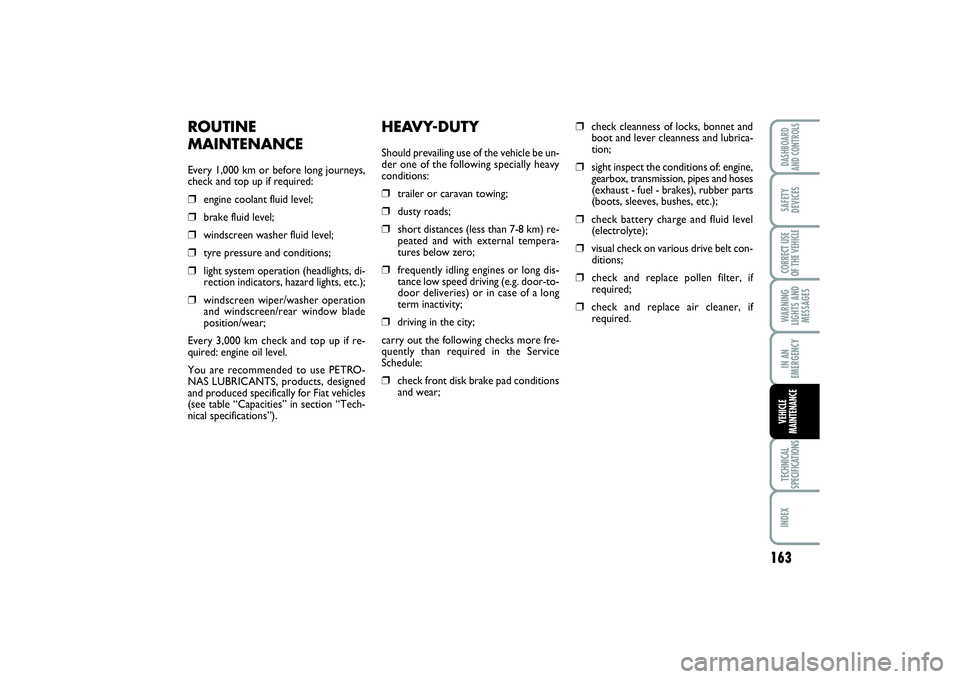
163
WARNING
LIGHTS AND
MESSAGESTECHNICAL
SPECIFICATIONSINDEX DASHBOARD
AND CONTROLSSAFETY
DEVICESCORRECT USE
OF THE VEHICLEIN AN
EMERGENCYVEHICLE
MAINTENANCE
HEAVY-DUTYShould prevailing use of the vehicle be un-
der one of the following specially heavy
conditions:❒
trailer or caravan towing;
❒
dusty roads;
❒
short distances (less than 7-8 km) re-
peated and with external tempera-
tures below zero;
❒
frequently idling engines or long dis-
tance low speed driving (e.g. door-to-
door deliveries) or in case of a long
term inactivity;
❒
driving in the city;
carry out the following checks more fre-
quently than required in the Service
Schedule:
❒
check front disk brake pad conditions
and wear;
❒
check cleanness of locks, bonnet and
boot and lever cleanness and lubrica-
tion;
❒
sight inspect the conditions of: engine,
gearbox, transmission, pipes and hoses
(exhaust - fuel - brakes), rubber parts
(boots, sleeves, bushes, etc.);
❒
check battery charge and fluid level
(electrolyte);
❒
visual check on various drive belt con-
ditions;
❒
check and replace pollen filter, if
required;
❒
check and replace air cleaner, if
required.
ROUTINE
MAINTENANCEEvery 1,000 km or before long journeys,
check and top up if required:❒
engine coolant fluid level;
❒
brake fluid level;
❒
windscreen washer fluid level;
❒
tyre pressure and conditions;
❒
light system operation (headlights, di-
rection indicators, hazard lights, etc.);
❒
windscreen wiper/washer operation
and windscreen/rear window blade
position/wear;
Every 3,000 km check and top up if re-
quired: engine oil level.
You are recommended to use PETRO-
NAS LUBRICANTS, products, designed
and produced specifically for Fiat vehicles
(see table “Capacities” in section “Tech-
nical specifications”).
159-178 SCUDO LUM GB 12/12/13 10.02 Pagina 163
Page 168 of 227
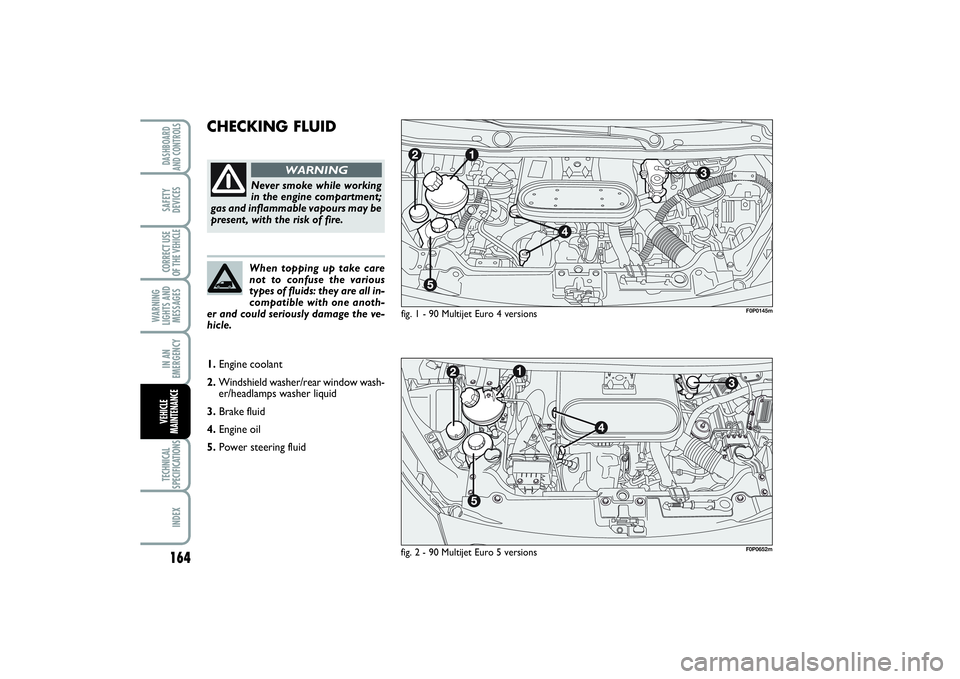
164WARNING
LIGHTS AND
MESSAGESTECHNICAL
SPECIFICATIONSINDEXDASHBOARD
AND CONTROLSSAFETY
DEVICESCORRECT USE
OF THE VEHICLEIN AN
EMERGENCYVEHICLE
MAINTENANCE
CHECKING FLUID
fig. 1 - 90 Multijet Euro 4 versions
Never smoke while working
in the engine compartment;
gas and inflammable vapours may be
present, with the risk of fire.
WARNING
When topping up take care
not to confuse the various
types of fluids: they are all in-
compatible with one anoth-
er and could seriously damage the ve-
hicle.
F0P0145m
1.Engine coolant
2.Windshield washer/rear window wash-
er/headlamps washer liquid
3.Brake fluid
4.Engine oil
5.Power steering fluid
fig. 2 - 90 Multijet Euro 5 versions
F0P0652m
159-178 SCUDO LUM GB 12/12/13 10.02 Pagina 164
Page 169 of 227
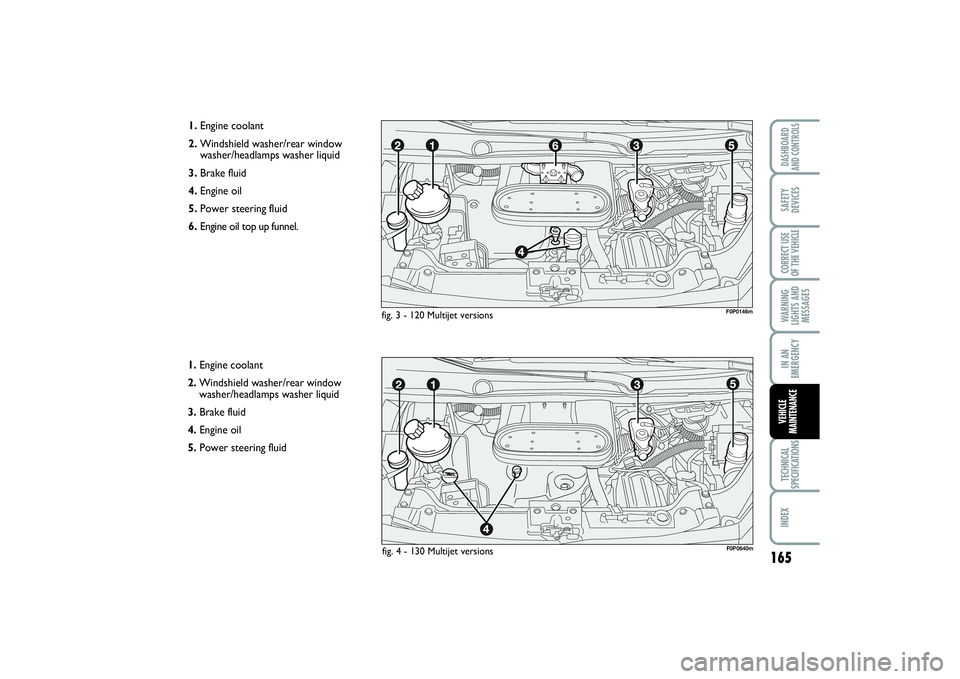
165
WARNING
LIGHTS AND
MESSAGESTECHNICAL
SPECIFICATIONSINDEX DASHBOARD
AND CONTROLSSAFETY
DEVICESCORRECT USE
OF THE VEHICLEIN AN
EMERGENCYVEHICLE
MAINTENANCE
1.Engine coolant
2.Windshield washer/rear window
washer/headlamps washer liquid
3.Brake fluid
4.Engine oil
5.Power steering fluid
6.Engine oil top up funnel.
1.Engine coolant
2.Windshield washer/rear window
washer/headlamps washer liquid
3.Brake fluid
4.Engine oil
5.Power steering fluid
F0P0146m
fig. 3 - 120 Multijet versions
F0P0640m
fig. 4 - 130 Multijet versions
159-178 SCUDO LUM GB 12/12/13 10.02 Pagina 165
Page 170 of 227
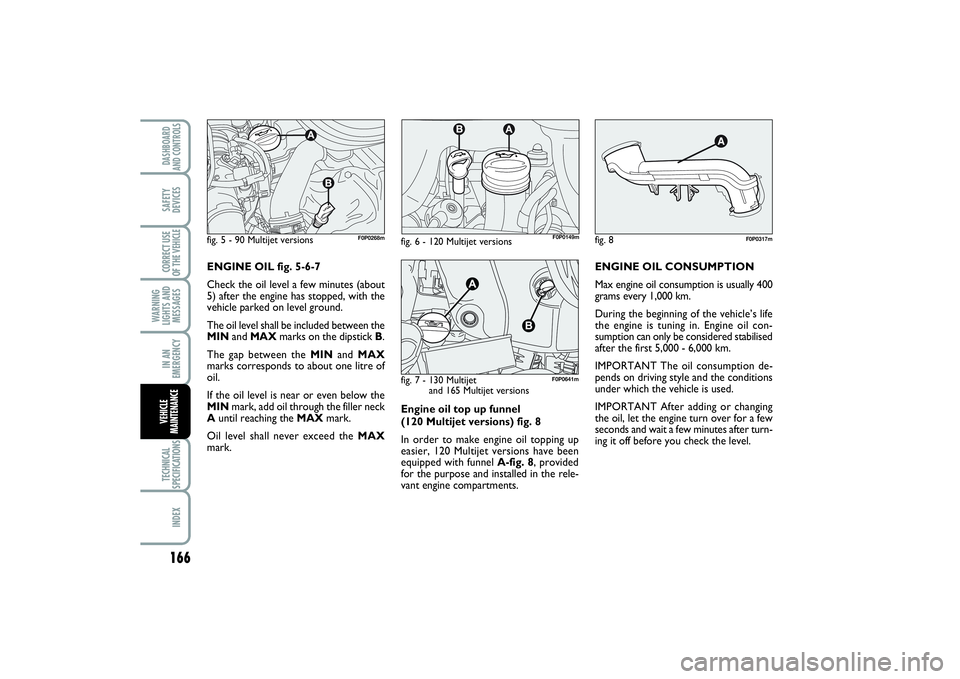
Engine oil top up funnel
(120 Multijet versions) fig. 8
In order to make engine oil topping up
easier, 120 Multijet versions have been
equipped with funnel A-fig. 8, provided
for the purpose and installed in the rele-
vant engine compartments.ENGINE OIL CONSUMPTION
Max engine oil consumption is usually 400
grams every 1,000 km.
During the beginning of the vehicle’s life
the engine is tuning in. Engine oil con-
sumption can only be considered stabilised
after the first 5,000 - 6,000 km.
IMPORTANT The oil consumption de-
pends on driving style and the conditions
under which the vehicle is used.
IMPORTANT After adding or changing
the oil, let the engine turn over for a few
seconds and wait a few minutes after turn-
ing it off before you check the level. ENGINE OIL fig. 5-6-7
Check the oil level a few minutes (about
5) after the engine has stopped, with the
vehicle parked on level ground.
The oil level shall be included between the
MINand MAXmarks on the dipstick B.
The gap between the MINand MAX
marks corresponds to about one litre of
oil.
If the oil level is near or even below the
MINmark, add oil through the filler neck
Auntil reaching the MAXmark.
Oil level shall never exceed the MAX
mark.
fig. 5 - 90 Multijet versions
F0P0268mF0P0149m
166WARNING
LIGHTS AND
MESSAGESTECHNICAL
SPECIFICATIONSINDEXDASHBOARD
AND CONTROLSSAFETY
DEVICESCORRECT USE
OF THE VEHICLEIN AN
EMERGENCYVEHICLE
MAINTENANCE
fig. 6 - 120 Multijet versionsfig. 8
F0P0317m
fig. 7 - 130 Multijet
and 165 Multijet versions
F0P0641m
159-178 SCUDO LUM GB 12/12/13 10.02 Pagina 166